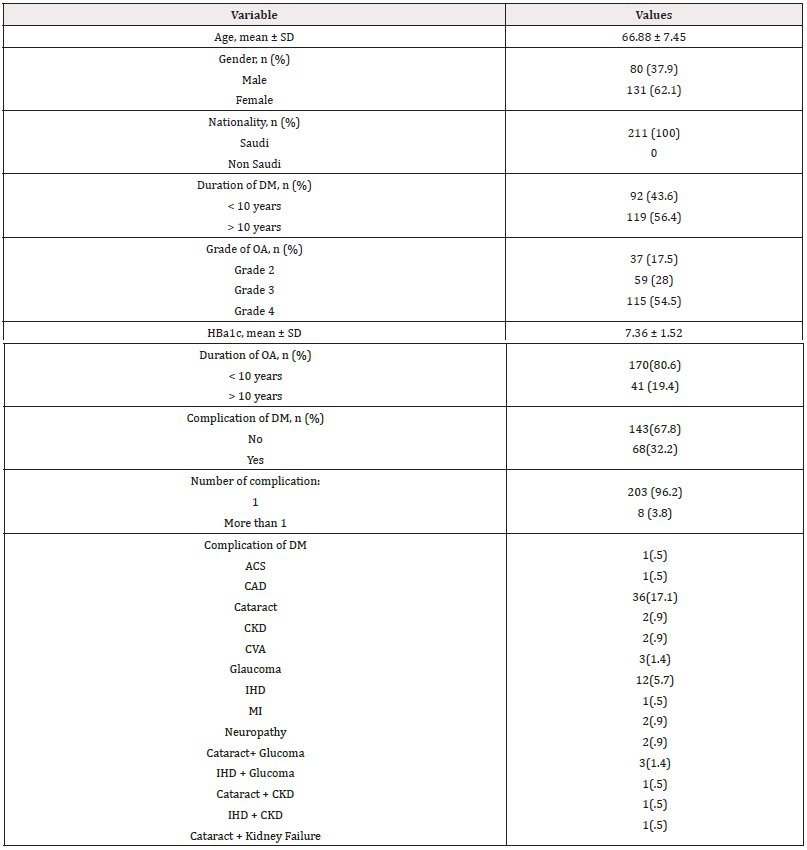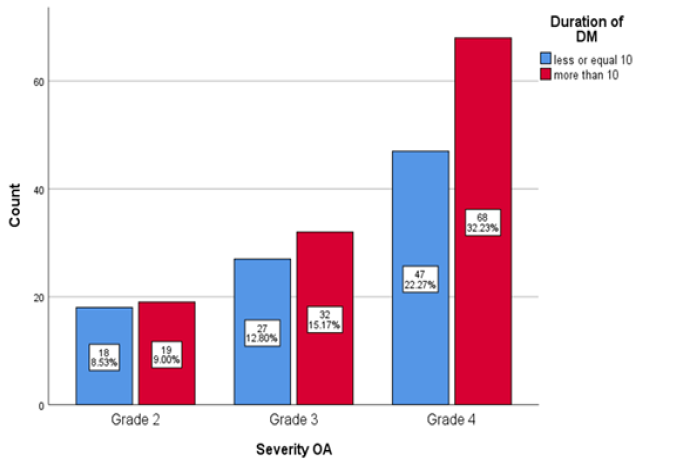Research Article 
 Creative Commons, CC-BY
Creative Commons, CC-BY
The Association between the Duration of DM and Blood Sugar Control with Osteoarthritis Severity Among Patients Attending the Orthopedic Clinics at King Abdullah Medical City, Makkah, Saudi Arabia
*Corresponding author: Adnan A Aladraii, Orthopedic department, king Abdullah medical city, Makkah, 24246, Saudi Arabia.
Received: November 4, 2024; Published: November 14, 2024
DOI: 10.34297/AJBSR.2024.24.003244
Abstract
Background: Osteoarthritis (OA) has become the most common chronic condition affecting the knee. Evidence suggests a possible link between diabetes mellitus (DM) and the amplification of OA symptoms and severity.
Objectives: The aim of this research is to determine the association between the duration of diabetes mellitus (DM) and blood sugar control, with the severity of knee osteoarthritis (KOA).
Material and Method: A retrospective cross-sectional study design was used with a sample size 211 diabetic patients with knee osteoarthritis who attended the orthopedic clinic at King Abdullah Medical City (KAMC). The collection of data encompassing age, gender, medical history associated with diabetes mellitus, and knee osteoarthritis was collected from patient medical records, and the grading of knee osteoarthritis severity was determined through the application of the Kellgren and Lawrence system.
Results: There was a good positive correlation between HbA1c and the severity of osteoarthritis (r = 0.015). The severity of knee osteoarthritis was higher among the patients who had diabetes for >10 years.
Conclusion: Research found a strong link between high HbA1c levels and the severity of knee osteoarthritis. Long-term diabetes patients had more severe osteoarthritis symptoms. Based on the study findings, we recommend implementing educational programs on osteoarthritis awareness for individuals with diabetes.
Introduction
A Osteoarthritis (OA) is a chronic condition affecting the knee which affects the older people is one of the main causes of limitation of their activity [1]. Depending on the cause, OA may be primary or secondary. However, both types can lead to articular cartilage degradation [2,3]. KOA has a greater impact on disability since it limits a person’s mobility and promotes dependency [4].
Osteoarthritis risk factors can fall into two categories: non-modifiable and modifiable. Certain elements, such as age, body imbalance or disability in the body, and gender, are considered non-modifiable factors. Modifiable risk factors include diabetes (DM), smoking, hypertension, body mass index, and hypercholesterolemia. [5,6]. Diabetes mellitus has been linked to development and progression of osteoarthritis, this could be attributed partly to diabetic peripheral neuropathy, which causes muscle weakness and in severe cases joint laxity [7].
Direct effects of hyperglycemia have been shown to damage cells and cause inflammation in a number of different tissues that are linked to diabetes problems. This includes a systemic inflammatory response that can affect joint tissues and help cause OA [8]. It is still unclear whether and how glucose directly affects the tissues and cells in joints [8]. High blood sugar can have indirect effects by making more advanced glycation end products (AGEs). These AGEs build up in OA cartilage as people age and cause inflammation and breakdown by activating their specific receptor, RAGE, on chondrocytes and synovial ells [8]. According to a prior study, type 2 diabetes independently predicts the onset of severe OA regardless of age or BMI [9]. Furthermore, some studies found that type 2 diabetes was a associated with decreased joint space in patients of osteoarthritis of the knee [10].
Research on the relationship between the duration of diabetes mellitus (DM), blood sugar control, and the severity of osteoarthritis (OA) remains controversial and limited. Thus, the aim of this research is to determine the association between the duration of diabetes mellitus (DM) and blood sugar control and the severity of knee osteoarthritis (KOA).
Subject and Methods
This study is a retrospective cross-sectional study that was done at King Abdullah Medical City (KAMC) in the period from September 2022 to October 2023. Data was collected from patient by calling them, and from the patient’s medical records in the hospital.
All patients with knee osteoarthritis, regardless of their gender or nationality, attending the orthopedic clinics at King Abdullah Medical City (KAMC) were included with exception of those patients who refused to participate, who are less than 18 years of age, and who are diagnosed with secondary osteoarthritis due to trauma or rheumatoid arthritis.
Statistical Analysis
Statistical analyses were performed using computer software [the Statistical Package for Social Studies (SPSS), version 25(IBM Corporation, Armonk, NY, USA)]. Data are expressed as mean± standard deviation or percentage values. Where Chi-squared test was performed to assess the significance of association between demographic factor in relation to severity and duration of osteoarthritis. Eta coefficients test used to determine the correlation. Statistical significance was set at p<0.05.
Results
The demographic and clinical features of the patients are shown in Table 1. 211 individuals were included in the study. (mean [SD] age 66.88 [7.45] years; 131 [62.1%] females; mean [SD] Hemoglobin A1c (HbA1c) averaged was 7.36 [1.52]). All patients were Saudi. In the duration, the duration of DM was 56.4 % of those who have a disease for more than 10 years, compared with 80.6% in the duration of OA for 10 years or less. Grade of OA was high in grade 4 with 54.5%. 143 out of 211 do not have any complication regarding DM, the rest have one complication with 96.2%. The most common complication of DM is Cataract with 17.1%. Figures (1 to 9) show the demographic characteristics of patients. The frequency of Severity OA in the patients with DM and duration for ≤10 years was 43.6%. There was no statistically significant difference between the two groups in terms of demographic characteristics (0.656). See Figure 10. The correlation of HBa1c and severity of osteoarthritis components with DM diagnosis was calculated. There was a good positive correlation between HbA1c and the severity of osteoarthritis (r = 0.015) (Tables 2,3).
Discussion
This study showed that there was an association between DM duration and the severity of osteoarthritis. Similar to, a previous study conducted in Bruneck indicated that the relationship between OA and type 2 diabetes shows that variations in glucose metabolism directly impair joint integrity regardless of body weight, creating optimism that effective regulation of glucose metabolism slows the development of OA [9]. Furthermore, type 2 diabetes is one of the risk factors associated with severe OA [9].
In study by Azizah et al, conducted to evaluate the risk factor of Osteoarthritis the found that Diabetes mellitus is one of the risk factors for development and progress of osteoarthritis [6]. Hyperglycemia has been shown to cause cell damage and a systemic inflammatory response that might affect joint tissues and contribute to OA pathogenesis [8]. Research indicates that diabetes decreases bone turnover. High levels of fasting glucose have been associated with knee joint bone marrow lesions, which can predict structural deterioration in osteoarthritis (OA) [11]. AGEs accumulate more in the subchondral bone of diabetic patients compared to non-diabetic patients, potentially affecting the mechanical strength of the bone and causing pro-inflammatory effects [12]. Additionally, diabetic advanced knee osteoarthritis is characterized by decreased subchondral bone density and increased porosity, regardless of weight [13].
This study established a clear positive correlation between elevated HbA1c levels and the severity of knee osteoarthritis. This, supported by results from many other studies which indicated that an increase in HbA1c level in diabetic patients was highly associated with development and severity of knee osteoarthritis [14]. Another cohort study by Zhang at el, correlate the elevated levels of HbA1c and fasting serum glucose with an increased likelihood of developing knee osteoarthritis (OA) and found direct association of high HbA1c with occurrence of knee osteoarthritis [15].
The recent evidence emphasized that male patients with symptomatic knee osteoarthritis were more likely to experience joint space narrowing if they had type 2 diabetes. [10] However, some research disagrees with this evidence as thy found that having an HbA1c level of 5.5 or higher was not directly linked to the progression of osteoarthritis but cumulative effect of dyslipidemia, hypertension, overweight and impaired glucose tolerance or blood sugar control is a risk factors for osteoarthritis [16].
There are some limitations for consideration. The study was conducted in a single hospital, thereby impeding the generalizability of the findings to all patients. Comprehensive follow-up and analytical studies are necessary to further explore the association of DM control and duration with knee osteoarthritis severity.
Conclusions
The research revealed a significant correlation between elevated HbA1c levels and increased severity of knee osteoarthritis. Moreover, patients with longstanding diabetes were observed to experience more pronounced symptoms of osteoarthritis.
Nevertheless, more in-depth investigations are essential to confirm the association between diabetes and the progression of knee osteoarthritis. Based on the study findings, we suggested the implementation of campaigns to help diabetic patients with OA better understand their condition.
References
- Health Quality Ontario (2018) Structured Education and Neuromuscular Exercise Program for Hip and/or Knee Osteoarthritis: A Health Technology Assessment. Ontario Health Technology Assessment Series 18 (8): 1-110.
- Michael JWP, Schlüter-Brust KU, Eysel P (2010) The Epidemiology, Etiology, Diagnosis, and Treatment of Osteoarthritis of the Knee. Dtsch Arztebl Int 107(9): 152-162.
- Hafez AR, Alenazi AM, Kachanathu SJ, Alroumi AM and Mohamed ES (2014) Knee osteoarthritis: a review of literature. Phys Med Rehabil Int 1(5): 8.
- Ashraf Ramadan Hafez, Aqeel Mohammed Alenazi, Shaji John Kachanathu, Abdulmohsen Meshari Alroumi, Elham Saed Mohamed (2014) Knee Osteoarthritis: A Review of Literature. Phys Med Rehabil Int 1(5): 8.
- Cross M, Smith E, Hoy D, Nolte S, Ackerman I, et al., (2014) The global burden of hip and knee osteoarthritis: estimates from the Global Burden of Disease 2010 study. Annals of the Rheumatic Diseases 73(7):1323-1330.
- Zheng J, Huang X, Huang J, Meng B, Li F, et al., (2022) Association of Diabetes Mellitus Status and Hyperglycemia With Symptomatic Knee Osteoarthritis. Arthritis Care & Research 75(3): 509-518;
- Al Jarallah K, Shehab D, Abdella N, Al Mohamedy H, Abraham (2015) Knee Osteoarthritis in Type 2 Diabetes Mellitus: Does Insulin Therapy Retard Osteophyte Formation? Medical Principles and Practice 25(1): 12-177.
- Mendes AF, Rosa S, Rufino AT, Ribeiro M and Judas F (2015) Diabetes-induced osteoarthritis: role of hyperglycemia in joint destruction. BMC Musculoskeletal Disorders 16(Suppl 1): S1
- Schett G, Kleyer A, Perricone C, Sahinbegovic E, Iagnocco A, et al., (2013) Diabetes is an independent predictor for severe osteoarthritis: results from a longitudinal cohort study. Diabetes care 36(2): 403-409.
- Eymard F, Parsons C, Edwards MH, Petit Dop F, Reginster, JY, et al., (2015) Diabetes is a risk factor for knee osteoarthritis progression. Osteoarthritis and cartilage 23(6): 851-859.
- Davies Tuck ML, Wang Y, Wluka AE, Berry PA, Giles GG, et al., (2012) Increased fasting serum glucose concentration is associated with adverse knee structural changes in adults with no knee symptoms and diabetes. Maturitas 72(4): 373-378.
- Franke S, Rüster C, Pester J, Hofmann G, Oelzner P, et al., (2011) Advanced glycation end products affect growth and function of osteoblasts. Clin Exp rheumatol 29(4): 650-660.
- Chen L, Jia C and Yang H (2023) Causal Effect of Higher Glycated Hemoglobin (HbA1c) Levels on Knee Osteoarthritis Risk: A Mendelian Randomization Study. Rheumatol Ther 10: 239-247.
- Wen CY, Chen Y, Tang HL, Yan CH, Lu WW, et al., (2013) Bone loss at subchondral plate in knee osteoarthritis patients with hypertension and type 2 diabetes mellitus. Osteoarthritis and cartilage 21(11): 1716-1723.
- Zheng J, Huang X, Huang J, Meng B, Li F, et al., (2023) Association of Diabetes Mellitus Status and Hyperglycemia With Symptomatic Knee Osteoarthritis. Arthritis Care & Research 75(3): 509-551.
- Yoshimura N, Muraki S, Oka H, Tanaka S, Kawaguchi H, et al., (2012) Accumulation of metabolic risk factors such as overweight, hypertension, dyslipidaemia, and impaired glucose tolerance raises the risk of occurrence and progression of knee osteoarthritis: a 3-year follow-up of the ROAD study. Osteoarthritis and Cartilage 20(11): 1217-1226.







 We use cookies to ensure you get the best experience on our website.
We use cookies to ensure you get the best experience on our website.